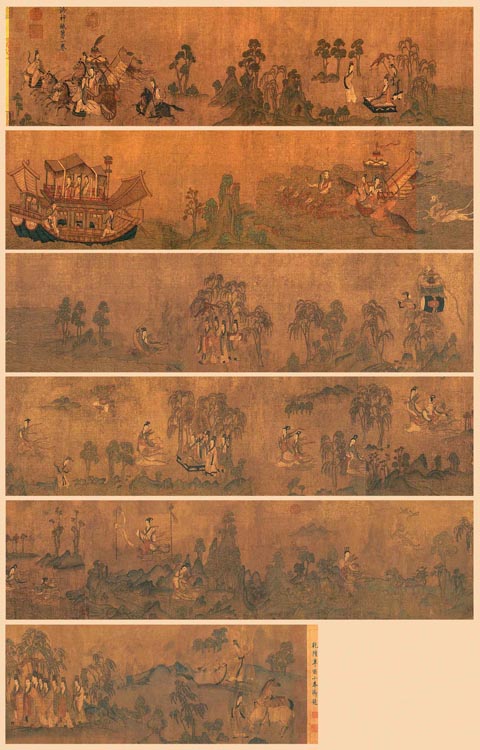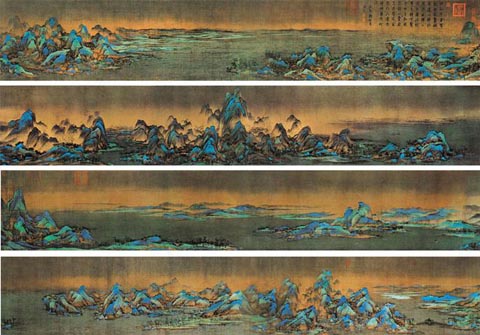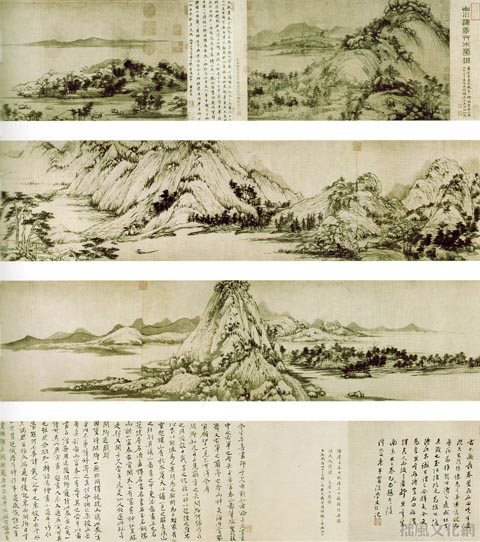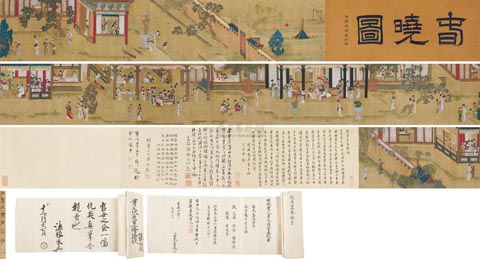|
Paintings or engravings found on precipitous cliffs are even more ancient. The bright red cliff paintings have strong visual effects in southern China that depict scenes of sacrificial rites, production activities and daily life. In comparison, hunting, animal grazing, wars and dancing are the main themes of cliff paintings in northern China.
Before paper was invented, the art of silk painting had been developing. The earliest silk painting was excavated from the Mawangdui Tomb in Changsha of the early time of Western Han (206BC-24AD). The painting on silk, a T-shaped Banner, had high artistic value and the skill of painting made much more progress.
The portraiture was developed after the Han Dynasty. During the Eastern Jin Dynasty (317AD-420AD) the famous painter Gu Kaizhi made great achievements on portraiture. His famous work Nushizhentu was handed down. The introduction of Buddhism from India had great influence on Chinese portraiture. Paintings of Buddhist divinities rapidly spread and developed. The religious-subject art in the form of sculptures and frescoes prevailed all over China during the Northern and Southern Dynasty (420-589AD). At the same time, the Taoist paintings were also developed.
In the Tang Dynasty (618-907AD), Buddhist and Taoist painting were flourishing. Wu Daozi and Yan Lide were representatives of these genres of religious paintings. The painting of beautiful women was another field of portraiture in the Tang Dynasty. Zhang Xuan and Zhou Fang are most famous painters of this kind.
Chinese Landscape Painting produced in the Eastern Jin Dynasty. Wuzhong Xishan Yiju Tu (the landscape of Wu) by Dai Kui and Xuejitang Wulaofeng Tu (the wulao Mountain in snow) by Gu Kaizhi were regarded as the earliest Chinese landscape paintings. During the Tang Dynasty, landscape painting was well developed but the portraiture was still dominated. There were a lot of famous painters appeared such as Wu Daozi, Li Sixun and Wang Wei. Wu Daozi was respected as painting sage by the late generations for his free, bold strokes and rich imagination, which regenerate the previous style of fussy delineation of details. Li Sixun was known for paintings of massive mountains and also for his skillful color rendering. Wu and Li were regarded as the founders of the Northern School of Chinese landscape painting. Wang Wei was famous for his free and fast strokes and novelty of conceptions. He applied the Broken-ink Style to paint thus he was regarded as the founder of Southern School of Chinese landscape painting. During the Tang Dynasty (618-907 AD), the culture flourished with the economic development. Painting was elegant in style, reflecting the general prosperity of the golden age of Chinese feudal society.
In Five Dynasties (907-960AD), landscape painting further developed. Jing Hao, Huang Quan, Guan Tong and Xu Xi were four famous painters. Jing Hao specialized in drawing mountain peaks surrounded by clouds. Guan Tong was fond of painting hills in autumn, forests in winter, rural habitations, country ferries, hermits and ect. His work achieved impressive effects with the use of few strokes and conveying rich meaning. Xu Xi specialized in painting flowers and fruits. He used mere drops of ink to form leaves, branches and flower buds, which gave his pictures an antique and distinguished effect. Huuang Quan, when painting flowers and birds, he made sketches first then filled colors. His skill of painting was called Shuanggouti (double sketch method).
In the Song Dynasty (960-1279AD), the most representative landscape painters included Li Cheng, Fan Kuan, Dong Yuan and Ju Ran. Lii cheng’s works were like long distance panoramas swept into view under the magic brush. The other three painters succeeded in creating a sense of reality in painting of distant hills and in changing colors without artificial sign. Emperor Huizong (1082-1135AD) was also a master of painting and calligraphy in the Song Dynasty. Ruihetu(auspicious cranes) and Furong Jinji Tu (pheasant on a blossoming branch) were regarded as his representative works. The paintings of Song Dynasty (960-1279AD), however, favored abstract, implied meanings rather than direct expressions, painting skills matured considerably, and the realistic style was in full blossom.
During the Yuan Dynasty (1271-1368AD), Hung Gongwang, Wang Meng, Wu Zhen and Ni Zan were most famous landscape painters. Huang’s painting was very close to nature and with very high artistic value. The Yuan Dynasty witnessed the flourish of the expressionist school and many painters indulged in painting solely for personal pleasure. Yuan literati painters no longer took truth to nature as their goal but rather used painting as a vehicle for self-expression. In the hands of highly educated scholar-artists, brushwork became calligraphic and assumed an autonomy that transcended its function as a means of creating representational
During the Ming Dynasty (1368-1644AD), landscape developed into three schools: Zhe, Wu and Yuan. Dijin was known to be the leader of the Zhe School. His paintings of gods, human beings, animals and flowers were very exquisite. Qiu Ying and Tang Yin represented the Yuan School. Shen Zhou, Wen Zhengming, Dong Qichang and Che Jiru were known as the four great landscape painters of the Wu School.
During the Qing Dynasty (1644-1911AD), the famous painters included the four Wangs: Wang Shimin, Wang Yuanqi, Wang Jian and Wang Hui, Monk Dao Ji and Badashanren (the eight famous recluse monks) and Yangzhou Baguai (Eight Eccentrics of Yangzhou) were also well known.They inherited a realistic tradition and were familiar with the the lives of ordinary people, they could expressed their feelings in their works. Their emergences marked a fresh advance in the history of Chinese painting and their works reflected the new aesthetic standards embodied in a realistic, traditional style. Wu Changshuo made extensive studies of inscriptions on ancient bronzes and stone tablets. He incorporated this into his painting. His brushwork gave impression of being cut or chiseled out of metal or stone. During the Ming and Qing Dynasty, innovation was stressed, and delicate seal marks, calligraphy, poems and frames increased the elegance and beauty of the Chinese paintings. The painters of Ming and Qing took painting as a medium to express their interests and feelings. They painted with a vigorous boldness, caring little for meticulous refinement. Gradually, Chinese painting became artistically “perfect” during the Qing Dynasty.
The 10 most reknowned Chinese paintings handed down from ancient times.
|
|
Traditional Chinese painting innovations
At the beginning of the 20th century, with the New cultural Movement, some painters from Shanghai, Hangzhou, Nanjing, Guangzhou and Beijing started to challenge the old tradition of Chinese painting by introducing new art concepts from the West and establishing art school to train artists. Most of these pioneer painters later became the backbone of New China's Art after 1949. And some are still active even today.
The ink painting has conducted certain reforms earlier this century, which may fall into two types. One reform was to get rid of the morbid psychology of self-admiration that some scholar painters in feudal China, and establishes a healthy style. In this respect Qi Baishi, stood high above his contemporaries.
Qi's favorite subjects included flowers, insects, birds, landscapes and human figures. He not only studied the skills of these forerunners such as Xu Wei, Zhu Da, Yuan Ji and Wu Changshuo but also carefully observed the objects that he sketched. Outwardly he seemed to be very casual, but the flowers and birds painted by his hand all possessed the characteristics they should have. With fluent lines and bright colors, he created a world full of life and rhythm.
The second type of reform was to accept Western art concepts and techniques and combine them with good tradition of Chinese painting. The pioneers tried to create a brand new national painting form on the basis of the existing form. One of the representatives in this bold experiment was Xu Beihong (1895-1953AD), who served in his lifetime as president of the Central Fine Arts Institute and chairman of the Chinese Artists Association.
Xu Beihong was most famous for his painting of horses. With a solid foundation in Chinese painting, he drew on the best techniques from Western painting. In his paintings of human figures or animals, he was most accurate in the depiction of both spirit and form. Xu Beihong works demonstrated his strong personality and creative spirit but also his patriotism, his sympathy with the working class, and his deep hatred for all evils.
Traditional Chinese painting is one part of quintessence of China’s traditional cultural heritage. It must be have vigorous life. It must carry forward in the future.
Classification of Chinese Traditional Painting
Traditional Chinese painting has its special materials and tools, consisting of brushes, ink and pigments, xuan paper, silk and various kinds of ink slabs. Based on different classification standards, Chinese traditional painting can be divided into several groups, as follows:
1. Techniques
According to painting techniques, Chinese painting can be divided into two styles: xieyi style and gongbi style. Xieyi, or freehand, is marked by exaggerated forms and freehand brushwork. Gongbi, or meticulous, is characterized by close attention to detail and fine brushwork. Freehand painting generalizes shapes and displays rich brushwork and ink techniques.
2. Forms
The principal forms of traditional Chinese painting are the hanging scroll, album of paintings, fan surface and long horizontal scroll. Hanging scrolls are both horizontal and vertical, usually mounted and hung on the wall. In an album of paintings the artist paints on a certain size of xuan paper and then binds a number of paintings into an album, which is convenient for storage. Folding fans and round fans made of bamboo strips with painted paper or silk pasted on the frame. The long, horizontal scroll is also called a hand scroll and is usually less than 50 centimeters high but maybe up to 100 meters long.
3. Subjects
Traditional Chinese paintings can be classified as figure paintings such as Buddha ‘s images and women’s figures, landscapes and flower and bird, fish and insect, paintings. Landscapes represent a major category in traditional Chinese painting, mainly depicting the natural scenery of mountains and rivers.
The features of traditional Chinese painting:
Traditional Chinese painting is an important part of China’s cultural heritage. It is executed on silk or Xuan Paper with Chinese brush, ink and pigments consisting of minerals and vegetable colors. Traditional Chinese painting seldom follows the convention of central focus perspective or realistic portrayal, but gives the painter freedom on artistic conception, structural composition and method of expression so as to better express his subjective feelings. Chinese painting has absorbed the best of many forms of art, like poetry, calligraphy, and seal engraving. The brush techniques so much emphasized in Chinese painting include line and texture (cunfa), the dotting method (dianfa) and the application of color (ranfa). For traditional Chinese painting, poetry, calligraphy and seal engraving are necessary components that can supplement and enrich the content and artistic attraction. "Painting in poetry and poetry in painting" has been a criterion for excellent works. Inscriptions and seal impressions
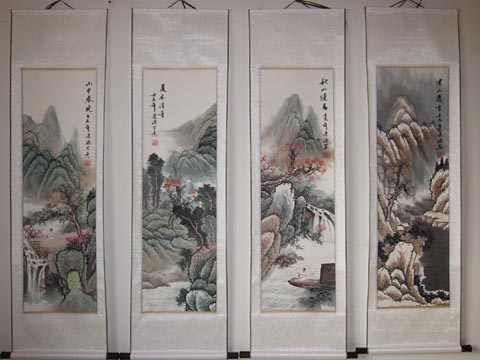 |
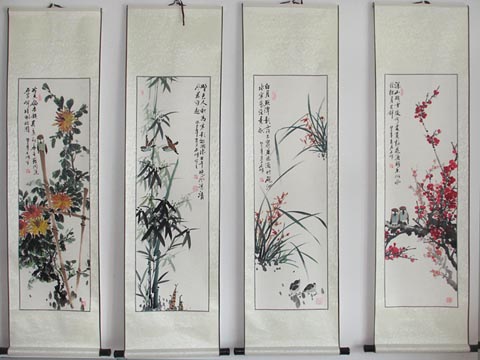 |
Four Seasons Scroll |
Plum
Blossoms, Orchid, Bamboo and Chrysanthemum Scroll |
Here are some Chinese paintings painted by famous artists on sale. If you have interest welcome to contact me.
Each painting of the Four Season Scroll
is 155x40cm and the center is 107x31cm. The whole set costs 350USD including
shipping. Each painting of the Plum Blossoms, Orchid, Bamboo and Chrysanthemum
Scroll is 140x39cm and the center is 95x29cm. The whole set costs 300USD
including shipping. If you want other Chinese paintings please tell me.
I can send you the pictures of the artist's work with flowers, birds,
characters, and landscape.
Mobile:(+86-1350 110 3837) Wechat:(13501103837) E-mail: chinasilkrug@msn.com
